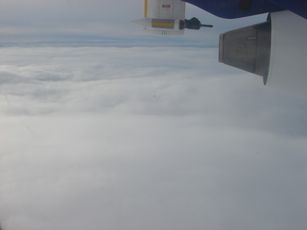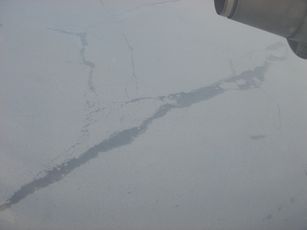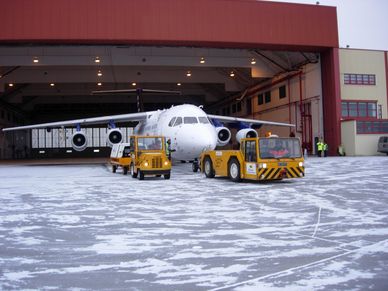|
|
 |
Friday 2nd - A 'Three Strikes and You're Iced Out' Mission
|
|
Friday's mission was aimed at investigating the structure of barrier winds along the MIZ southeast of Greenland, more specifically in the Denmark Strait, and heat fluxes associated with the NE wind flow. This would be accomplished by flying two cross sections, first at high level followed by extreme low level, cutting nicely and perpendicularly through the barrier wind jet.
Strike One
Bob Wells once again transported an anxious and mission-ready bunch of scientists, this particular morning consisting of Kent, Ian, Carling, Inge, Dave and Tadayasu, to the gates of Keflavik Airport. Security measures had obviously been tightened up, and we were treated with a full body search, only leaving out a potential strip search (phew..). More trouble with the van surfaced with a defect cigarette lighter failing to supply power to the mobile rotating beacon. After a short stall by the security staff we managed to dodge that bullet – Strike One – and proceeded to the designated hangar located at the military section of the aerodrome.
|
|
|

|
|
Strike Two
In order to escape the dreaded de-icing procedure (and therefore more ground handling as the instrument pods need to be protected/covered during de-ice), the aircraft was kept in the hangar throughout the night. Settling in at our respective stations we observed some light precipitation, so the pods had to be covered and we were eventually towed out from the hangar, ready to spool up the fans and commence rolling. Flight manager Alan suddenly posed a concerned grin, a something rotton-look, reporting that we didn't have GPS signals. Strike Two. And an anxious ten-fifteen minutes, some of us wondering if we would soon be on the return van following a scrapped flight. But oh no, Alan Whooly finally cheered us up with a thumbs up.
High Flying
The first leg had us at 26 kft dropping a total of five sondes every 50 nm, and we flew above a relatively high and dense cirrus layer, maybe somewhat thicker and more pronounced compared to what we expected. Then we made a 90 degree turn banking to our right, flying NE and parallell to Greenland at our left hand side. Visual conditions were, well «grayish». Seemed like a hazy cirrus layer was obstructing an otherwise clear view of Greenland, but some details could be mapped out. After circa 25 minutes or 125 nm we banked 90 degrees right, commencing a new drop sonde sequence (a total of four sondes) as we flew a SE-ly track. The leg ended near NW Iceland, and the high-level drop sonde data revealed interesting wind speed maximums associated with the low level jet exceeding 30 m/s, comfortably consistent with preflight expecations. |
Strike Three – Malfunction, Your Iced!
Ascending rather quickly in order to begin the 100 feet asl towards the NE again we encountered moderate icing as we descended. Passing through 10 kft the icing was to such an extent that one of the engine fan blades accumulated enough ice to provoke a «malfunction» warning. The intercom maintained a «chilling» silence for a little moment as we continued our descent, the crew maintained their professional «cool», and before we knew it the ice on the blades were long gone. According to our visuals out the window, ice was still accumulating, and Alan Foster reported icing on the wind shields including the heated section.
Fair to say that we may have penetrated a cloud layer characterized by severe icing?
Eventually we reached the 100 feet level, but after a short while Alan and Steve reported from the cockpit insufficient horizontal visibility, forcing us to climb a few hundred feet. Ice was still glued to the instrument pods, and the turbulence probes were long ago iced up. Eventually visibility improved and we returned to 100 feet. Temperatures at flight level were close to -8 to -10 degrees Celsius, and with little hope of ice removal coupled with probability for more airframe icing, we eventually decided to bank left and seek relatively warmer waters such as to warm our precious turbulence probes from their freezed state. We must have had a 50-65 kts tail wind while flying SW-ly, and the seas were visibly «disturbed» with streaks, white caps, and sea spray. Near surface temperatures gradually, albeit slowly, increased while Alan and Steve up front provided some additional mechanical heating by adding some more RPM to the engines. Some ice was shedded, but unfortunately the turbulence probe failed to come back to life. Temperatures were up to circa -2 degrees Celsius, but with little hope of reaching positive numbers the decision was made to abort the mission and return to home base. Strike Three. Out!
|
|
|
|





